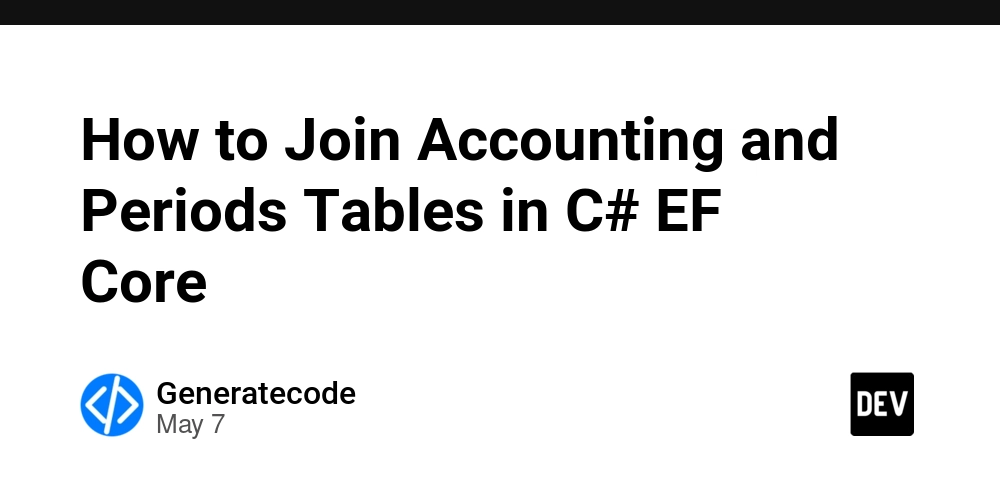How to Join Accounting and Periods Tables in C# EF Core
Introduction In this tutorial, we will explore how to effectively join the AccountingEntity and PeriodEntity when using Entity Framework Core in C#. The aim is to filter AccountingEntity based on a Group parameter while ensuring the Period property is properly initialized from the Periods table. This is a common scenario when dealing with related database tables in a fixed schema situation. Understanding the Relationship We are working with two tables: periods and accounting. The primary key in the periods table is a combination of group and id, while the accounting table has periodid that corresponds to id in periods. The relationship between these tables is established by matching accounting.periodid with periods.id, although no foreign key is defined in the schema. Correcting the Entity Framework Configuration To set up the relationship in Entity Framework Core, we will modify the OnModelCreating method in the FinanceDbContext. Since periodid in AccountingEntity refers to id in PeriodEntity, we can define this relationship in the following way: modelBuilder.Entity() .HasOne(a => a.Period) .WithMany() .HasForeignKey(a => a.PeriodId) // Defines the foreign key relationship here .OnDelete(DeleteBehavior.Restrict); // Optional: define delete behavior In this configuration, we use WithMany() instead of WithOne(). This is because each PeriodEntity can be associated with multiple AccountingEntity entries, representing a one-to-many relationship. Implementing the GetAll Method Now that we have correctly set up the relationships, we can proceed to implement the GetAll method in the repository: public IQueryable GetAll(string group) { return DatabaseContext.Accountings .Include(a => a.Period) // Eager loading the related Period entity .Where(a => a.Period.Group == group); // Filter by group } In this method, we utilize Include to perform eager loading, ensuring that the Period property of each AccountingEntity is populated. The Where filter then checks if the Group of the Period matches the input parameter. Conclusion By properly configuring the relationships in Entity Framework Core and using eager loading in our query, we can effectively retrieve AccountingEntity records that are filtered based on related Period attributes. This approach avoids the overhead of list properties in your entities, maintaining clean and efficient models. Frequently Asked Questions (FAQ) How do I set up relationships in Entity Framework Core? Use the OnModelCreating method to define primary keys, relationships, and constraints between entities. Eager loading can be done using the .Include() method. Can I avoid loading entire related objects? Yes, you can use projection to select only specific properties if full entities are not necessary. Use .Select() to create anonymous types or DTOs. What if I want to filter on multiple columns? You can chain additional .Where() clauses together to filter based on other properties as needed, using logical operators to combine conditions.

Introduction
In this tutorial, we will explore how to effectively join the AccountingEntity and PeriodEntity when using Entity Framework Core in C#. The aim is to filter AccountingEntity based on a Group parameter while ensuring the Period property is properly initialized from the Periods table. This is a common scenario when dealing with related database tables in a fixed schema situation.
Understanding the Relationship
We are working with two tables: periods and accounting. The primary key in the periods table is a combination of group and id, while the accounting table has periodid that corresponds to id in periods. The relationship between these tables is established by matching accounting.periodid with periods.id, although no foreign key is defined in the schema.
Correcting the Entity Framework Configuration
To set up the relationship in Entity Framework Core, we will modify the OnModelCreating method in the FinanceDbContext. Since periodid in AccountingEntity refers to id in PeriodEntity, we can define this relationship in the following way:
modelBuilder.Entity()
.HasOne(a => a.Period)
.WithMany()
.HasForeignKey(a => a.PeriodId) // Defines the foreign key relationship here
.OnDelete(DeleteBehavior.Restrict); // Optional: define delete behavior
In this configuration, we use WithMany() instead of WithOne(). This is because each PeriodEntity can be associated with multiple AccountingEntity entries, representing a one-to-many relationship.
Implementing the GetAll Method
Now that we have correctly set up the relationships, we can proceed to implement the GetAll method in the repository:
public IQueryable GetAll(string group)
{
return DatabaseContext.Accountings
.Include(a => a.Period) // Eager loading the related Period entity
.Where(a => a.Period.Group == group); // Filter by group
}
In this method, we utilize Include to perform eager loading, ensuring that the Period property of each AccountingEntity is populated. The Where filter then checks if the Group of the Period matches the input parameter.
Conclusion
By properly configuring the relationships in Entity Framework Core and using eager loading in our query, we can effectively retrieve AccountingEntity records that are filtered based on related Period attributes. This approach avoids the overhead of list properties in your entities, maintaining clean and efficient models.
Frequently Asked Questions (FAQ)
How do I set up relationships in Entity Framework Core?
Use the OnModelCreating method to define primary keys, relationships, and constraints between entities. Eager loading can be done using the .Include() method.
Can I avoid loading entire related objects?
Yes, you can use projection to select only specific properties if full entities are not necessary. Use .Select() to create anonymous types or DTOs.
What if I want to filter on multiple columns?
You can chain additional .Where() clauses together to filter based on other properties as needed, using logical operators to combine conditions.









































































